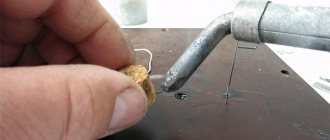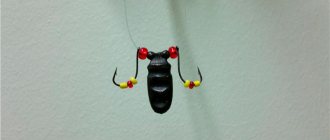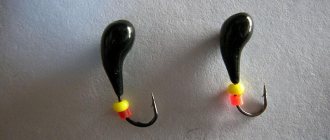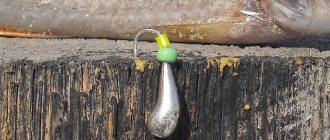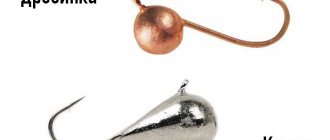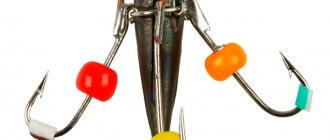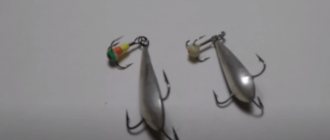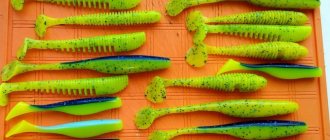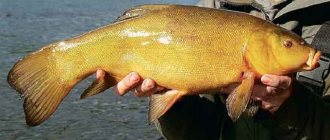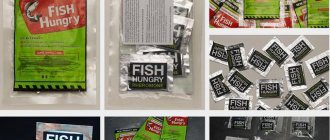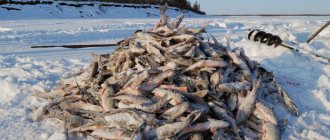In reelless fishing, the nailball jig occupies a special place. Some fishermen use these baits as the main ones in ice adventures. Catching fish with nailballs is a great start for beginners in the no-reeler game. This bait is easy to learn and versatile. However, as in all fishing, there are some nuances and features, the observance of which determines the success of fishing.
Reelless jigs
More and more fishermen are joining the ranks of fishermen. This is convenient for city dwellers - there is no need to prepare bloodworms, the gear fits in a small box (or just in your pocket). With the right approach, reelless fishing will give a head start to a bait jig. Some beginners put the reelless nailball jig at the forefront, considering it the most catchy jig. This is probably wrong. There are many reelless jigs, each of them works great in specific conditions.
The advantage of fishing with nail balls is its versatility and ease of mastering the correct game. This reelless jig makes mistakes for beginners in the game, just like the attached jig. The fish are attracted by the light ball, knocking on the body of the bait. When it comes to winter roach and rudd, nailballs are the undisputed leaders. Perch takes equally well on any bait. But bream, silver bream and other flat-bodied whitefish react better, after all, to live bloodworms.
Design Features
The nailball jig was made on the basis of the good old post, adding a large bead to the hook. As they say, this jig was developed as a result of experiments by Dzerzhinsky fishermen in the vast Volga. Since then, reviews of jigs and nail balls have been positive - these baits, with the right approach, always catch, even in the dead of winter. Time has shown which shapes, colors, characteristics of the bead and body of the jig work. It turned out that the most universal shape of the jig is a nail, a brass (golden tungsten) or green (cat's eye) bead and a black (dark green) color of the bait. This is a definite plus - you don’t need to experimentally try out hundreds of reelless options on ice. You take a standard black nailless nailball (brass or cat's eye) and catch it. Experiments are carried out with the game, without bothering with changing baits.
What does a working nailball jig look like?
Due to the hype, the market has become filled with various bait options. However, that very correct nail ball remains unchanged. You should not fall for marketing and advertising tricks. The set necessary for fishing has long been known. Experiments waste time and money. As an example of an ideal jig, consider the “Trick” nail balls. These designer jigs are made taking into account all requirements.
However, they have an appropriate price. If you search in fishing stores or on the Internet, you can find decent baits cheaper. The highest quality products at this moment are Mast Iv nail balls (Ivanovo), Nizhny Novgorod and designer jigs (Ulovka and others). The mothless set is assembled from mostly black jigs, you can add a few dark green ones and a couple of brightly colored ones. Balls - brass or cat's eye. Cat's eye jigs are made not only with green beads - there is a wide range of colors. But the most popular ones are green (for roach), orange (crucian carp, perch) and white (pearl, milky) for bream.
Studs with Brass Ball Trick
The right choice is the key to successful biting
The basis of the set is black carnations of various weights. The most popular size of a nailball jig is medium, 0.35-0.6 grams. Pendants are right on the hook, not the “earrings” that fill the stores. The basis of the arsenal consists of black nails with brass balls (silver or multi-colored ones work worse), several with cat's eye beads (green, a pair of white, orange) and ribbed decoys (faceted balls, nail cubes). You also need a couple of bright acid columns in stock - someday they will help out. So, the base is a black nail, the bead is brass 3-4 mm in diameter (golden fly fishing tungsten head), green cat's eye. The rest is within the framework of experiments.
Various pendants - standard and “earring”
In the dead of winter, it is the black color of the jig that works best. This hides the size of the bait in the water; the fish sees only a light ball. For active biting in the spring or in the first ice, jigs with decorations (sparkles on the body), as well as multi-colored variations, work well. In this case, the fish bait is perceived as an integral, larger object.
Nails are made of tungsten or lead, the former being correspondingly heavier. Nail balls have a relatively large hook. Grip is better with larger hooks. On the right nail ball, the bead is made with a relatively large hole with ground off ends - this allows the ball to slide smoothly along the hook and accurately tap the body of the jig when playing. Accordingly, the distance between the forearm and the sting and the bend of the hook are selected so as not to limit the hinge of the bead.
Factors affecting fish
Operating factors of nail ball catchability:
- The bead itself attracts fish with its color and round shape.
- The knock of the ball on the bait during the game.
- Nodding the top of the nail down when retrieving (due to the high center of gravity of the jig).
Rainbow faceted ball (chameleon)
The game of a nail ball with a tungsten ball and, for example, a glass cat's eye, differs due to the difference in the weight of the pendant. It is generally accepted that glass beads (multi-colored) work better in shallow water, and heavy brass, tungsten or faceted metal (shiny) work better in depth. However, this is an experimental question. The weight of the suspension affects the game, but these differences are subtle, and they affect the bite. Therefore, the set should contain various rewinders - it is not known in advance what will work best on the reservoir today.
Balloons
So, the direct working element of the nail ball is the bead itself. The studs themselves in a fisherman's set can be identical in shape, differing only in weight. Their main function is to add mass to the total weight of the jig for proper play and quick delivery of the ball to the desired fishing horizon. It is better if the ball hole is counterbored, and the part adjacent to the jig is recessed (for better contact and knock).
Mandarin for crucian carp and perch
The common earring pendant also works for a good bite, so you can still stock up on a couple of jigs of this configuration. Now there are many offers on the market with beads made of metal, glass and plastic. In recent seasons, nail cube jigs or faceted nail balls have been gaining popularity. The multifaceted nail ball sparkles in the depths and creates other vibrations at the micro level. Basic set of pendants:
- Most jigs are brass balls and green glass ones.
- Several white, orange cat eyes.
- A pair of cubes or faceted balls.
cat's eye
Classics and modifications
Reviews from experienced wormers say that the main emphasis should be on using classic black jigs with brass balls. This option is time-tested and works in all conditions. Silver balls, two beads, an earring pendant are additional options that do not always work. In muddy water, sometimes a sharp-eyed nailball with a provoking bright green bead shows itself, especially on active pre-spring roach. Shimmering polyhedrons perform well at great depths with sluggish play.
Clove cube
Therefore, we rely on the classics as a basis. We test other options in conditions when the classic does not work. This part of the standard reelless tactics is a constant search for both the place and the working bait, its game.
Vigorous eye
Nail balls, nail cubes, devils and uralka
Gvozdesharik – a jig of the Gvozdik type, with a metal ball mounted on the shank of the hook. Jig Gvozdik + ball = Nailball. It is believed that the high catchability of the Nailball is associated with the sound made by the jig when the ball hits the body of the jig during play. This is the most popular jig among other nail-shaped jigs.
Nailballs
Gvozdekubik - like Nailball, a bait based on the Gvozdik jig. Unlike the Nail-ball, on the shank of the hook of the Nail-cube there is not a ball, but a metal cube. Jig Gvozdik + cube = Gvozdekubik. The operating principle and catchability of this jig are the same as that of a jig with a ball.
Nail cubes
The Gvozdik jig, being the prototype of various nail-shaped jigs (nail ball, nail cube, nail diamond, etc.) is a simple-shaped bait with one hook. Despite some external similarity with the elongated species of Chertikov and Uralok, winter jigs Gvozdik are a separate species.
There are quite a lot of varieties of the “Gvozdik” jig, these are the jigs described above with a ball or cube suspended on the fore-end, faceted or multi-faceted “Gvozdik”, “Column”, “Match”, etc. and so on.
Chertik (Devil) - a jig with three hooks soldered into the body of the jig or a hanging tee. This is one of the first, time-tested jigs for baitless fishing for perch and peaceful fish. The devil is one of the most catchy winter baits.
Devil
Uralka (Uralochka, Ural jig) is an elongated drop-shaped bait with a bend, which is the prototype of most reelless jigs for baitless fishing. In skillful hands, a winter fishing rod with Uralka is a very catchy tackle.
Uralochka
What can you catch, which fish is better to catch?
For fish, the “Nailball” and other similar jigs are universal. They are good for catching perch, roach, bream, bluegill and silver bream. Other fish won't let this jig pass by either. Perch and roach are caught more often on the Nailball, but since these are the most common fish species in our reservoirs.
DIY making
Many fishermen make jigs and nail balls with their own hands. The base is simple to make - it’s a standard jig of nails. A jig is made by soldering a hook into a tungsten or lead block, after which the workpiece is brought to the desired configuration with a file and painted. In our case, the main problem is to correctly place the ball of the desired configuration. Beads with a small hole cannot be threaded through the sting. A large ball does not fit through the bend of the hook.
In this case, before soldering, the eye of the hook is bitten off, the ball is put on the forend, and then both parts are tinned and sealed in a lead blank with tin. This is painstaking and delicate work, but the result is the right nail ball. To avoid the hassle, some fishermen simply hang the bead on an earring, however, this is wrong.
In order to make a stud jig with a ball, special tungsten fly fishing heads for heavy flies are well suited. Among them, we choose the option that is needed - golden (brass) colored beads with a large hole (1.5-2 mm in diameter). Such a bead is put on a hook through the eye, and then the blank with the ball already on is soldered into the body of the future nail ball. It is important to choose the right hook.
Fly fishing tungsten heads
It is better to use high-quality products from well-known brands. Requirements: a long fore-end, a straight hook, a bend of the eye to the sting at an angle of 30-45 degrees. Hooks No. 14 are excellent for tying flies (for medium-sized nailballs). The pendant attached to the hook should move freely along the fore-end. Therefore, the body of the jig after soldering should not occupy more than half the length of the fore-end. With the proper skill, the glass beads are also carefully bored out with a drill, then they fit perfectly into the hook through the eye.
Making a nail ball
What you will need
In order to make a nail ball yourself, you will need a supply of tungsten balls or glass beads (size from 2.8 to 4 mm), as well as hooks from number 14 to 18.
Manufacturing process
It is better to solder the body for the bait from tungsten wire, which is suitable in diameter. You can also use steel wire, but it is worth considering that its weight is slightly less. The tungsten ball compensates well for the lack of weight loss due to the body material.
In simplified cases, a jig is made by gluing a workpiece to a hook. When making this jig, it is imperative to take into account that there must be an intermediate distance for the ball to move. It is for this reason that the body of the bait should reach the beginning of the bend of the hook. The made bait must be painted dark green or black, this is the most (best) option.
Equipment
Equipping a spooler with a nail ball follows the rules without a nozzle. Light tackle with a nod or nodless fishing rods are used. A set of fishing rods is prepared in advance - for each jig weight separately. There is no time to do bandaging and adjustments on a pond, especially in cold weather. It’s easier to take the finished tackle out of the box and use it right away. To start, 3-5 fishing rods with classics and a couple with modifications are enough.
A nailball, like any other rewinder, requires a thin, high-quality fishing line in the equipment. For most cases, a diameter of 0.1 mm is suitable, for large fish and heavy jigs - 0.12 mm. It is not recommended to bet thicker - there will be no correct game. The weight of the bait should completely straighten the line into a line. Over time, as you gain experience, it is better to generally switch to diameters of 0.08-0.09 mm.
A special part of the equipment is the nod for the rewinder. The simplest option for a nail ball is a nod made from X-ray film, lavsan or a plastic bottle. Next, you can try double-cone spring guards, dovewing or carbon (carbon). The requirements for setup and equipment are the same as for any reelless jigs. All this is described in detail at the links provided. The main thing in a reelless jig is the equipment that allows you to reproduce the correct game with a jig. An article about rigging reelless nodding fishing rods.
How to properly tie a nailball jig to a fishing line? There are several working methods for tying a rewinder to a fishing line. However, experienced bleeders claim that the most correct method is with a loop. With such a binding, the nail ball plays better, creating additional micro-oscillations of the upper part horizontally due to the hinge of the connection. The loop is made small - 5-10 mm, it is formed with a regular figure eight or Rapala knot. An article about the correct binding of rewindless reels.
Rapala knot
Fishing and game technique
Fishing with a nail ball is tactically carried out according to all the rules of reelless fishing. Two basic pillars are active search and correct jig play. These components vary depending on the type of fish, the time of winter and the conditions of the reservoir. Fish react differently to bait. A black stud with a brass ball is universal, a cat's eye is a roach killer.
Even winter crucian carp can often be seduced by a nail ball with a tangerine orange bead. Bream, silver bream (and roach) love white milky balls or polyhedrons glistening in the depths. Baitless perch, especially during periods of activity, take various bait options. During periods of fish activity, provocative nail balls work on the first and last ice - a vigorous eye, as well as bright colors of nails (green, red, yellow, striped). Different fish prefer different game strategies:
- Perch, ruff – high-frequency, fast, sharp fluctuations, varied game.
- Bream – slow and steady retrieve
- Crucian carp - sluggish stretching and lowering, tapping on the bottom.
- Roach, rudd, ide - depending on the winter period. This is both an active game and a smooth, slow one. Roach often takes when playing down.
Fishing technique for fishing with a nail ball
Let's look at how to properly fish with nail balls. Compared to other hammerless games, the nailball is easier to master - failures in the game when your hand is not yet fully developed are not so fatal. Ball studs work at different amplitudes and frequencies. You just need to choose the wiring that attracts fish in specific conditions. Over time, each bezmotilchik develops its own specific game. The game consists of cycles. Each cycle is a specific combination repeated several times without changes.
The advantage of a nail ball is that you don’t have to follow the cycle and change combinations. Often it is a change in the game or the speed of the retrieve that brings the bite. There is no point in memorizing all the hundreds of different individual combinations. You need to start with a few basic ones, and after a certain amount of fishing, the hand itself will “feel” the necessary rhythm.
To create a sharper game, the fishing rod is held with a vertical grip, like a pencil, with a downward nod. A horizontal grip is more suitable for creating smooth and amplitude bream retrieves using a nod.
Basic postings
- Slow rises and falls with constant dribbling (saw) from the bottom to a height of about a meter. The goal is to determine the working horizon. After the bites, we fish at the height at which the fish touched. Dribbling on roach is less amplitude and frequency than on perch. And for bream and crucian carp very slow fluctuations are made.
- Dropping game. It works well for roach, especially when the fish are active or have at least bitten a little (several have already been caught and there is a lot of excitement under the ice).
- Slow rise and fall without play - often works in the dead of winter.
- Shaking 3-5 cm at the bottom. It works when the fish only takes from the bottom or near it.
- Pauses are useful. When to do them and for what duration - the reservoir will show. Unlike other reelless fish, the fish often takes the nailball during pauses, like a jig.
- Various provoking glitches in the game - running away, sudden stops and pauses, acceleration.
Tactics for fishing with nail balls are active search and fishing of horizons. In large areas and in deep winter areas, it is better to use bait. It is useful to return to the feeding holes and check them some time after the biting has stopped. You can’t put in a lot of bait; in winter you can saturate the fish very quickly. The fisherman’s goal is not to feed, but to stir up, attract and gather fish to the fishing point.
Subscribe to the channel:
My YouTube channel RYBAFAN on fishing:
We're OK
Bait game
Fishing without bait. Nailball Trick
The frequency of movement of the jig should not exceed 350 movements per minute. When catching perch, you don’t have to invent any extraordinary movements, since this predator is quite primitive compared to other fish. When catching white fish, you will have to try a little with a set of movements. Usually, the movements do not stop even while the jig is lowering to the bottom. But do not forget about organizing pauses, otherwise productive fishing will not work.
When fishing for roach, it is better to lower the fishing rod vertically and play with the bait to obtain longitudinal and transverse movements, which attracts the roach more. Bites can be very neat and unnoticeable, the main thing is not to yawn.
When fishing for bream, it is advisable to raise the fishing rod at an angle of 150-160 degrees, and the vibrations are reduced to 150 per minute.
It is very important to choose the right nod that takes into account the weight of the jig and other fishing conditions. The best nods are those made from the spring of a mechanical watch.
